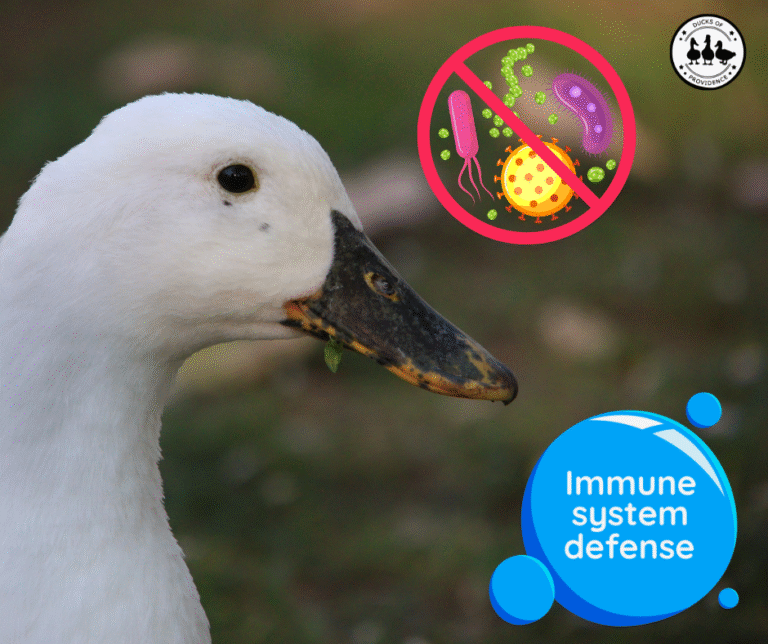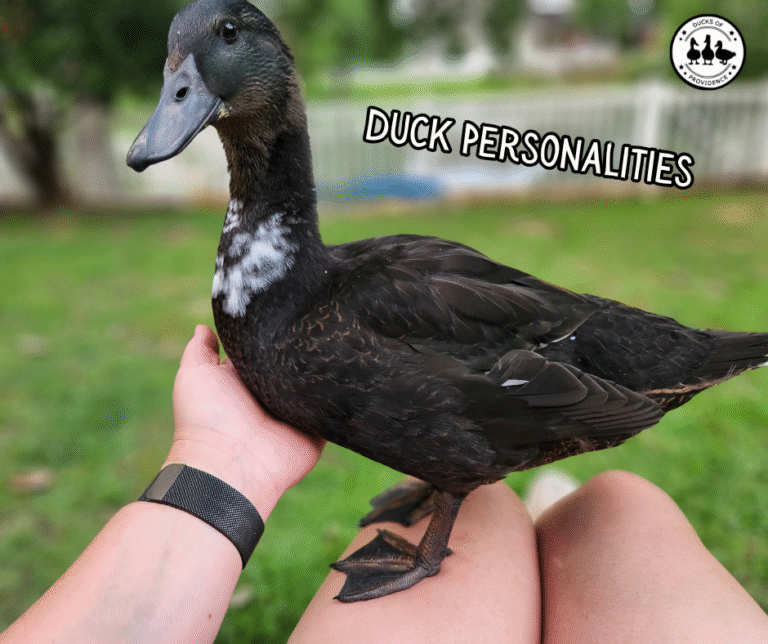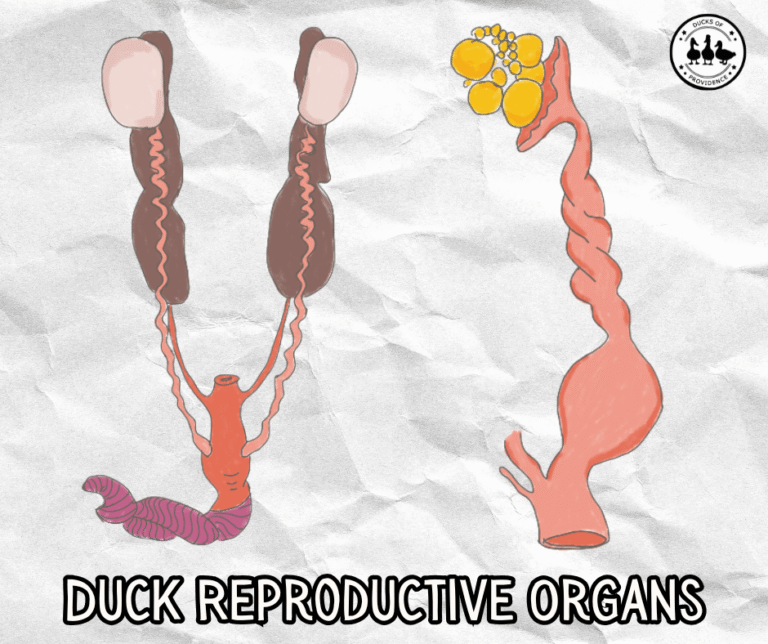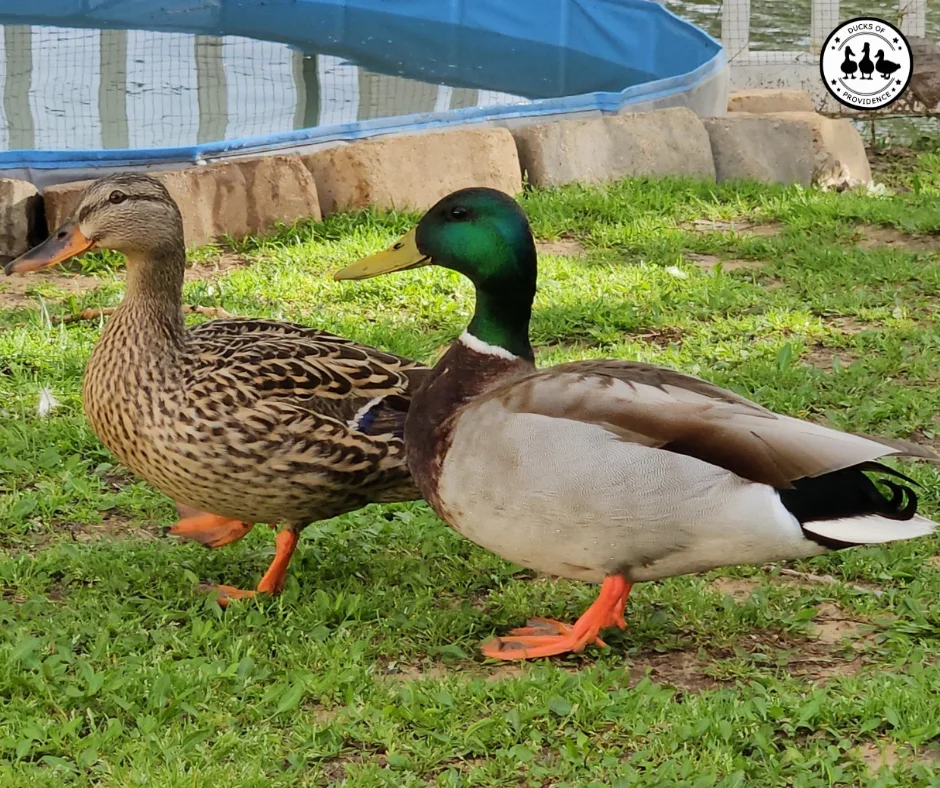
Male vs Female Ducks Explained: From Bills to Behaviors
Last updated on March 23rd, 2025 at 01:26 pm
Have you ever wondered what truly sets male and female ducks apart? This post takes you into the world of duck gender dynamics, covering everything from their distinct calls and appearances to the ways their behaviors differ.
Here’s what we’ll explore:
- The physical traits that help you recognize drakes versus ducks at a glance
- Unique behavioral differences between males and females
- Practical tips on flock management, from ideal male-to-female ratios to addressing challenges like over-mating
- And the big question: Are males or females more friendly?
Whether you’re a seasoned duck keeper or just beginning to explore duck care, our guide to male vs. female ducks is packed with insights to enhance your understanding. Let’s dive into the fascinating world of drakes and ducks!
What are Male and Female Ducks Called?
Male ducks are commonly referred to as “drakes,” while female ducks are known as “ducks” or “hens.” These terms have roots in old English and have been used for centuries to describe the two genders of these beloved waterfowl.
Additionally, young ducks are often called “ducklings.” So, in your flock, you may have drakes, ducks (or hens), and adorable little ducklings waddling about, each with their own unique charm!
How to Sex Ducks:
Sexing a duck involves determining whether it is male or female. There are several methods used for sexing ducks:
- Voice Sexing: This method involves listening to the vocalizations of the duck. Male ducks typically make softer, raspy calls, while female ducks produce loud quacks.
- Physical Characteristics:
- Plumage: In some duck breeds, males and females may have different plumage colors or markings. Males may have more vibrant or iridescent plumage, while females may have duller colors.
- Curly Tail Feathers: Some breeds of male ducks develop curly, or “drake,” feathers on their tails during the breeding season. This trait is more common in certain breeds like Mallards and Pekins.
- Bill Freckles: Female ducks may develop freckles or spots on their bills as they mature, particularly during the breeding season. These bill freckles are more common in certain breeds and can serve as a visual indicator of maturity and reproductive readiness.
- Behavioral Differences: Male ducks may exhibit more aggressive or territorial behavior, especially during the breeding season. They may also engage in courtship displays to attract females.
- Vent Sexing: This method involves examining the cloaca (vent) area of the duck to look for differences in anatomy that indicate its sex. However, vent sexing requires experience and is typically performed by professionals. Please do not attempt it yourself, as you can potentially harm your duck.
- DNA Testing: DNA testing can provide definitive results for sexing ducks, but it is usually only done for breeding or research purposes due to the cost and complexity involved.

It’s important to note that some methods, such as vent sexing and DNA testing, require specialized knowledge and equipment. In contrast, voice sexing, observing behavioral differences, and identifying physical characteristics like curly tail feathers and bill freckles can be more accessible to backyard duck enthusiasts.
How Can You Reliably Determine the Sex of a Duck?
The most reliable method for determining duck gender is vent sexing, which involves examining the duck’s genital anatomy. This method is typically performed by experienced professionals or veterinarians who are trained to identify the differences between male and female ducks based on internal structures visible through the vent. Vent sexing provides definitive results and is commonly used in commercial duck production and breeding operations.
However, vent sexing requires specialized training and expertise to perform accurately, as the differences between male and female duck genitalia can be subtle and require careful examination. Additionally, this method is typically used on ducklings when they are very young, as their vent area is more pliable and easier to manipulate for examination. Watch the video from a reputable breeder, Metzer Farms, below to learn how they perform the sexing on day-old ducklings.
While vent sexing is the most reliable method for determining duck gender, it is impractical for individual duck owners or hobbyists without proper training and experience. In such cases, other methods, such as voice sexing or observing secondary sexual characteristics like plumage coloration and behavior, may be used to make an educated guess about duck gender.
Male vs Female Ducks Differences
When it comes to telling male and female domestic ducks apart, there are several key differences beyond just their names:

- Plumage:
- Male Domestic Ducks (Drakes): Often exhibit more vibrant and iridescent colors, with glossy green heads, vibrant blue wing patches, and chestnut-brown chests common in breeds like the Mallard-derived breeds.
- Female Domestic Ducks (Ducks or Hens): Tend to showcase more subdued brown tones, providing camouflage for nesting and protecting nestlings. In breeds like the Khaki Campbell, females may have uniform khaki-colored plumage.
- Body Size and Features:
- Male Domestic Ducks: Typically have slightly larger bodies and more pronounced features compared to females, though this can vary depending on the breed.
- Female Domestic Ducks: Often have smaller, more streamlined bodies, optimized for nesting and caring for young.
- Bill Coloration:
- Male Domestic Ducks: Some breeds, like the Rouen, may have a distinct greenish hue to their bills, especially during the breeding season.
- Female Domestic Ducks: Bill coloration in females can vary depending on the breed, with some exhibiting a more muted orange or yellow bill.
- Sound Differences:
- Male Domestic Ducks: Tend to produce lower-pitched calls, often characterized by a raspy or quacking sound. This can vary depending on the individual and breed.
- Female Domestic Ducks: Emit softer and more subtle calls, especially during nesting and maternal care. The sound of female ducks can be gentler compared to their male counterparts.
- Curly Drake Feather:
- Some male domestic ducks, particularly in breeds like the Mallard-derived breeds, may develop a distinctive curled feather, known as a “drake feather,” on their tail, usually appearing around 2-3 months of age.
These differences play a crucial role in breeding, behavior, and overall management of domestic duck flocks, allowing enthusiasts to appreciate the diversity and charm of these beloved waterfowl.
Male vs Female Duck Colors
When it comes to distinguishing male and female domestic ducks, there are several general differences to consider. These differences can vary depending on the breed, with some exhibiting prominent distinctions while others may have minimal variations. Here’s a breakdown:
- General Differences:
- Male Ducks (Drakes):
- Tend to have slightly larger bodies and more pronounced features compared to females.
- Plumage may be more vibrant and iridescent, with glossy green heads and chestnut-brown chests being common characteristics.
- Some males may develop distinct curled feathers, known as “drake feathers,” on their tails as they mature.
- Female Ducks (Ducks or Hens):
- Often, they have smaller, more streamlined bodies optimized for nesting and caring for young.
- Plumage showcases more subdued brown tones, providing camouflage for nesting and protecting nestlings.
- Male Ducks (Drakes):
- Specific Examples of Domestic Duck Breeds:
- Mallard:
- Males: Exhibit glossy green heads and vibrant chestnut-brown chests.
- Females: Show more muted brown tones in their plumage.
- Rouen:
- Males: Often have distinct greenish hues to their bills and may exhibit larger body size than females.
- Females: Bill coloration may be more subdued, with smaller body size than males.
- Welsh Harlequin:
- Males: Exhibit striking green iridescent head feathering, which is a prominent feature distinguishing them from females. They may also have golden yellow-colored bills in maturity.
- Females: Display more subdued coloration over their bodies compared to males. They share the blue wing bar coloring with males. Additionally, in maturity, females tend to have darker, greenish bills compared to the golden-yellow bills of males.
- Bill Coloration: In ducklings, the bill color starts out dark, but changes occur by 5 days of age. This transformation is particularly noticeable in mature ducks, where males develop golden yellow bills while females retain darker, greenish bills.
- Khaki Campbell:
- Males: Have khaki brown-colored bodies with dark coffee-colored heads that may have a green sheen to them. They also have dark tail feathers and more pronounced features compared to females. The head of the drake is significantly darker than the duck’s, making it easier to determine gender.
- Females: Exhibit a more uniform khaki brown plumage with slightly darker heads and necks compared to the rest of their bodies. The head of the female is notably lighter than that of the male, providing a visual distinction between the genders.
- Cayuga:
- Both Genders: Display jet black plumage, black feet, legs, and bills, making it challenging to differentiate between males and females based on coloration alone. Drakes do sometimes have a greener sheen, especially on their heads.
- Females: As they mature and molt each summer, females may start to develop white feathers among their black plumage. This transition, characterized by the appearance of white feathers among the black ones, is completely normal and is a notable feature of female Cayuga ducks.
- Pekin:
- Both Genders: Pekin ducks are known for their distinct white plumage, making it challenging to differentiate between males and females based on color alone.
- Bill Coloration: Both males and females may exhibit variations in bill coloration, with some individuals having orange bills and others having yellow bills. This variation does not typically correlate with gender.
- Plumage and Size: Males and females may have similar body sizes and plumage, with no prominent differences between the genders in adulthood.
- Indian Runner:
- Males: They may have distinct greenish hues on their bills and a more upright posture than females.
- Females: Tend to have more subdued bill coloration and a more horizontal posture.
- Mallard:
Understanding these distinctions can help duck enthusiasts appreciate the unique characteristics of different domestic duck breeds and effectively manage their flocks.
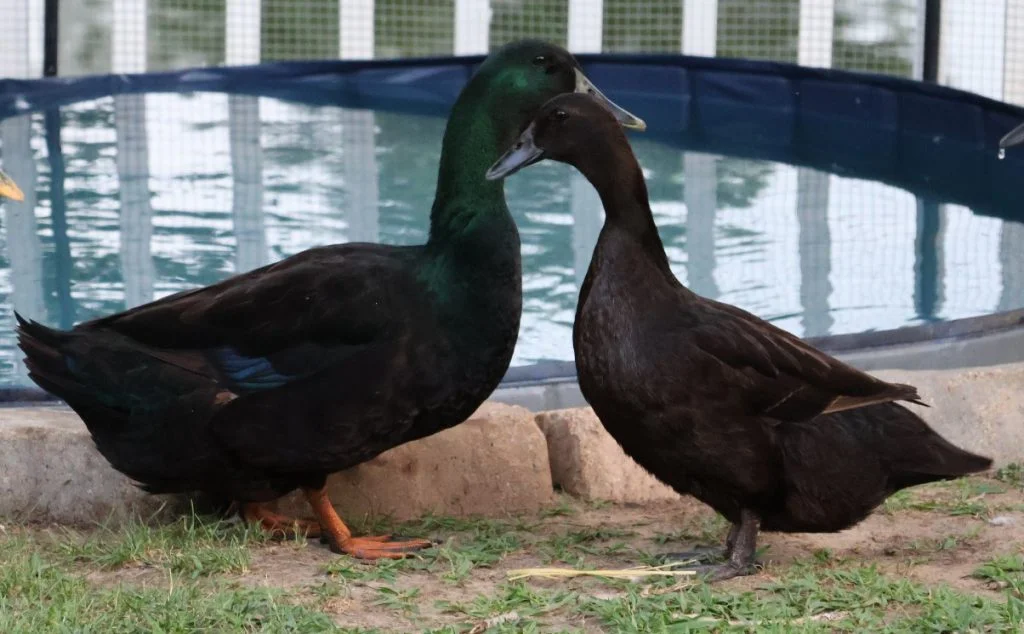
Freckles on Female Duck Bills: A Natural Phenomenon
In some female ducks, particularly among certain breeds, you may notice the development of freckles or spots on their bills as they mature. This intriguing occurrence, often referred to as “bill freckling,” is a natural phenomenon that can add to the unique charm of these beloved waterfowl.
Why It Happens:
- Hormonal Changes: Bill freckling in female ducks is often attributed to hormonal changes, particularly during the breeding season. As females prepare for nesting and egg-laying, fluctuations in hormone levels can influence pigmentation patterns on their bills.
- Melanin Production: The development of freckles on the bill is closely tied to melanin production, the pigment responsible for coloration in feathers, skin, and other tissues. Melanin serves various functions in ducks, including protection against UV radiation and regulation of body temperature. During periods of increased hormonal activity, such as egg production, melanin distribution on the bill may become uneven, leading to the formation of freckles or spots.
- Egg Production and Yolk Color: Melanin production in female ducks is also linked to egg production and yolk color. Ducks that produce eggs with darker yolks often have higher concentrations of melanin in their tissues, including their bills. The presence of freckles on the bill may indicate robust egg production and a higher likelihood of producing eggs with darker yolks, which are often prized for their nutritional value and visual appeal.
Significance:
- Maturity Indicator: Bill freckling is often considered a sign of maturity in female ducks, signaling their readiness for breeding and nesting activities. This visual cue can be helpful for duck enthusiasts in monitoring the reproductive health and behavior of their female ducks.
- Individual Variation: It’s essential to recognize that not all female ducks will develop bill freckles, and the extent of freckling can vary among individuals within the same breed. Factors such as age, genetics, and environmental conditions may influence the presence and intensity of freckles on the bill.
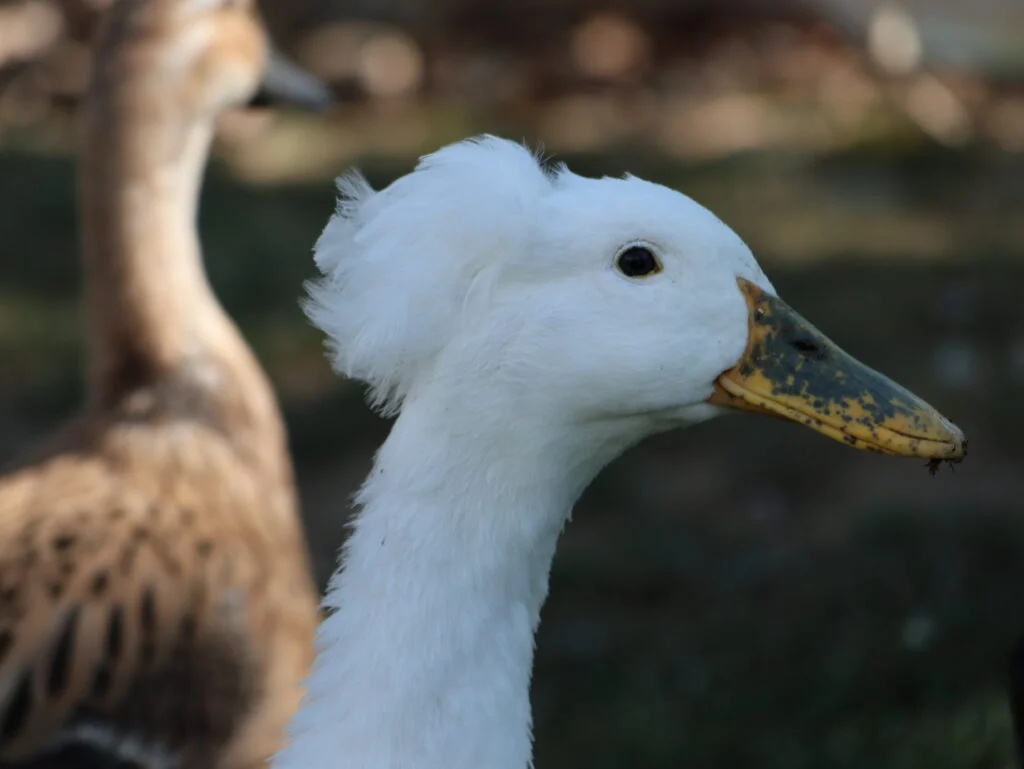
Freckles on the bills of female ducks are a fascinating natural phenomenon driven by hormonal changes, melanin production, and genetic factors. While bill freckling adds to the individuality and beauty of female ducks, it also serves as a visual indicator of maturity and readiness for breeding. By understanding the role of melanin in egg production and its relation to bill freckling, duck enthusiasts can gain a deeper appreciation for the intricate interplay between biology, behavior, and reproductive physiology in ducks.
Do Male or Female Ducks Grow Faster?
In the race to adulthood, ducklings of both genders grow at similar rates during their early days. However, male ducks may exhibit slightly faster growth as they mature due to hormonal differences and genetic factors. Nevertheless, providing a nutritious diet and ample space for exercise ensures healthy development for all ducklings, regardless of gender.
Male vs Female Ducks Sound
Male and female ducks of domestic breeds produce distinct vocalizations, each serving unique purposes in communication and social interaction within the flock.
Voice sexing, which involves identifying the distinctive vocalizations of male and female ducks, is considered the most reliable method for distinguishing between the genders. While visual cues such as plumage coloration and physical characteristics can vary among breeds and individuals, the vocal differences between males and females are generally consistent. They can be used with confidence for sex determination.
Male Duck Sound:
- Quacking and Raspy Calls: Male ducks, known as drakes, of domestic breeds, often produce quiet, raspy calls reminiscent of someone who has indulged too much in whiskey and cigars.
- Courtship Calls: During the breeding season, male ducks emit a variety of vocalizations to attract females and establish dominance within the flock. Depending on the species and individual behavior, these courtship calls can range from low-frequency grunts to high-pitched whistles.
- Aggressive Vocalizations: In territorial disputes or interactions with other males, drakes may produce aggressive vocalizations characterized by loud quacks and hissing sounds. These vocal displays help assert dominance and establish social hierarchy within the flock.
Female Duck Sound:
- Typical Quack Sound: Female ducks, also known as hens, of domestic breeds typically produce the classic “quack” sound associated with ducks. Their calls are often more pronounced than those of males, reflecting their role in nesting, incubating eggs, and caring for young.
- Nesting Calls: During nesting and egg-laying, female ducks may emit soft clucking sounds or low murmurs to communicate with their mates and maintain contact within the flock. These nesting calls help coordinate breeding activities and ensure the safety of the nesting site.
- Maternal Calls: After hatching, female ducks use maternal calls to communicate with their ducklings and guide them in foraging and navigation. These calls are characterized by gentle chirps and murmurs, reassuring and guiding the vulnerable ducklings.
Duckling Sound:
- High-Pitched Peeping: Ducklings of domestic breeds produce high-pitched peeping sounds shortly after hatching, serving as a means of communication with their mother and siblings. These calls help maintain contact within the brood and signal distress or hunger.
- Sound Changes with Age: As ducklings grow and develop, the sounds they produce gradually change in pitch and frequency. Around 2-4 weeks of age, the vocalizations of female ducklings of domestic breeds begin to transition, reflecting the onset of sexual maturity and the development of adult vocalizations. Male ducklings of domestic breeds may develop their voices much later, around 6 to 8 weeks of age. During this transition, they are sometimes voiceless or may sound hoarse as their vocal cords mature.
Understanding the nuances of duck vocalizations, from the distinctive calls of males and females to the endearing peeps of ducklings, provides valuable insight into the complex social dynamics and communication patterns of domestic duck breeds.
➡️ Read more about duck sounds in our post Duck Quacking Explained
Are Male or Female Ducks Louder?
When it comes to vocalizations, female ducks are definitely MUCH louder than drakes.
- Female Ducks:
- Loud Honking-Type Noise: Adult female ducks are known for making a louder honking-type noise. Their voices are much louder compared to males.
- Individual “Honk-Honk,” “Quack-Quack,” or “Uht-Uht” Noises: Females tend to produce individual “Quack-Quack” noises, which can be quite audible and attention-grabbing.
- Male Ducks:
- Low, Raspy Voice: In contrast, male ducks have a low, raspy voice. While they may not be as loud as females, their vocalizations have a distinctive quality.
- Low Chattering “WaWaWaWaWa” Sounds: Males often emit low chattering sounds, described as “WaWaWaWaWa.” This vocal pattern, reminiscent of a frog’s croak, is characteristic of male ducks.
- More Vocal: Males are often more vocal than females, directing the flock and calling to females, especially during the breeding season.
The combination of these vocalizations and their respective volumes plays a crucial role in communication and social dynamics within duck flocks.
Male vs Female Duck Behavior
When it comes to behavior, male and female ducks exhibit distinct tendencies shaped by their evolutionary roles. Drakes often engage in elaborate courtship displays to woo potential mates, showcasing their colorful plumage and performing intricate rituals.
Female ducks, on the other hand, prioritize nesting and caring for their young, displaying nurturing behaviors to ensure the survival of their offspring.
Male Duck Behavior:
Courtship Displays: Male ducks, known as drakes, exhibit elaborate courtship displays during the breeding season to attract females. These displays often involve dramatic movements such as head bobbing, wing flapping, and vocalizations, showcasing their fitness and attractiveness as potential mates.
Territoriality: Drakes tend to be more territorial, especially during the breeding season when competition for mates is fierce. They may vigorously defend their territory or mate against other males, engaging in aggressive displays and vocalizations to establish dominance within the flock.
Leadership: Within the flock, male ducks often take on leadership roles, directing the movement of the group and alerting others to potential threats. Their vigilant behavior helps ensure the safety and cohesion of the flock, particularly during times of heightened activity or danger.
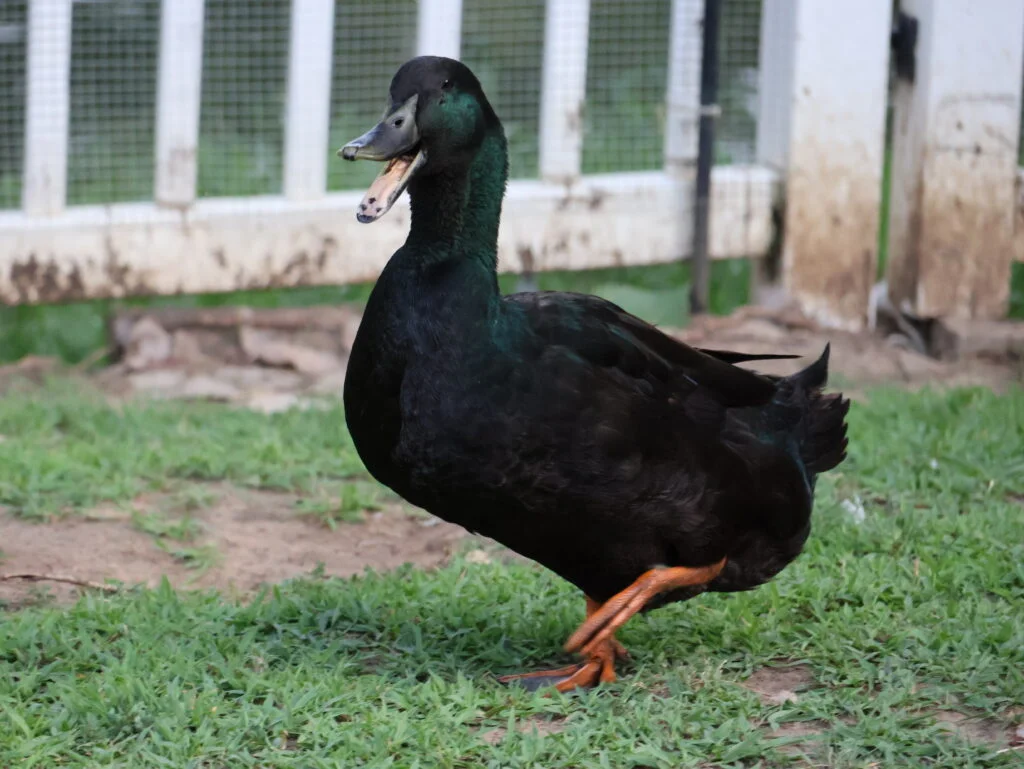
Female Duck Behavior:
Nesting and Incubation: Female ducks, or hens, are primarily responsible for finding suitable nesting sites and incubating the eggs. They exhibit behaviors such as nest building, egg laying, and incubation, often seeking out secluded areas away from predators to ensure the safety of their offspring.
Maternal Care: After the eggs hatch, female ducks provide attentive maternal care to the ducklings, leading them to water sources, teaching them to forage, and protecting them from predators. Their nurturing behavior ensures the survival and well-being of the next generation within the flock.
Socializing: Hens tend to be more social and cooperative within the flock, engaging in activities such as foraging and grooming with other females and ducklings. Their strong social bonds foster a sense of community and mutual support, enhancing the overall cohesion of the flock.
Communication: Female ducks communicate with quacks and murmurs, often used to maintain contact with their mate and offspring and coordinate group activities. These vocalizations serve as a means of bonding and cooperation within the flock, facilitating effective communication among its members.
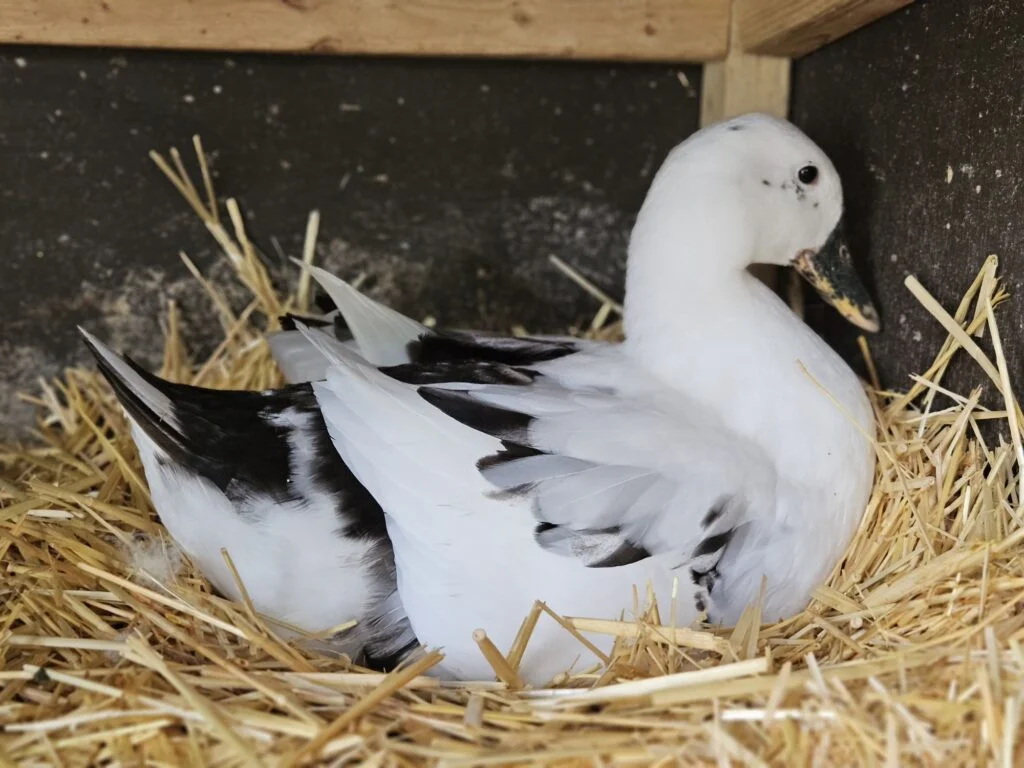
Male vs Female Ducks: How Many Male Ducks to Female Ducks?
Finding the right balance of male-to-female ratio in a duck flock is essential for maintaining harmony and reproductive success. While there’s no one-size-fits-all answer, a general rule of thumb is to have one drake for every three to five ducks. This ratio helps prevent male aggression while ensuring ample opportunities for successful mating.
Maintaining Harmony and Reproductive Success: Determining the optimal ratio of male to female ducks within a flock is crucial for fostering harmony and maximizing reproductive success. While no definitive answer applies to all situations, a commonly recommended guideline suggests maintaining a ratio of approximately one drake for every three to five ducks. This balanced ratio serves several important purposes in managing a duck flock.
Mitigating Male Aggression: Maintaining a suitable ratio helps mitigate the risk of male aggression, which can occur when too few females are available for mating. In situations with too few females relative to the number of males, competition among the males for mating opportunities may intensify, leading to aggressive behavior such as fighting and excessive mounting attempts. Ensuring that there are an adequate number of females for each male reduces the likelihood of aggressive interactions among the males, promoting a more peaceful and harmonious flock environment.
Promoting Successful Mating: A balanced male-to-female ratio increases the chances of successful mating and fertilization. With sufficient females available, each drake has ample opportunities to engage in courtship behavior and mate with receptive hens. This can result in a higher rate of successful egg fertilization, contributing to the overall reproductive success of the flock.
Addressing the Problem of Over-Mating: However, maintaining an appropriate male-to-female ratio also helps address the potential problem of over-mating. When there are too few females relative to the number of males, individual hens may be subjected to excessive mating attempts by multiple drakes. Over-mating can lead to physical injuries, stress, and reduced egg production in the affected hens. Ensuring a balanced ratio minimizes the risk of over-mating, promoting the health and well-being of the entire flock.
In conclusion, while the ideal male-to-female ratio may vary depending on factors such as breed, flock size, and management practices, striving for a ratio of one drake for every three to five ducks is generally recommended. This balanced ratio helps prevent male aggression, promotes successful mating, and mitigates the risk of over-mating, contributing to the overall welfare and reproductive success of the duck flock.
Are Male or Female Ducks Friendlier?
When it comes to friendliness, both male and female ducks can form strong bonds with their human caretakers. However, individual temperament plays a significant role, with some ducks displaying more outgoing personalities than others. Whether you prefer the playful antics of a drake or the gentle demeanor of a duck, there’s no shortage of affection to go around in a well-loved duck flock!
Individual Temperament and Socialization: When it comes to assessing the friendliness of ducks, both male and female ducks have the capacity to form strong bonds with their human caretakers. Their affability is often influenced by individual temperament and early socialization experiences.
Variability in Personality: Some ducks, regardless of gender, exhibit outgoing and sociable personalities. They eagerly interact with humans and seek attention and affection. These ducks may eagerly approach their caretakers, eagerly awaiting treats or affectionate interactions.
Unique Personalities: However, it’s important to recognize that each duck is unique, and their level of friendliness can vary greatly from one individual to another. While some ducks may readily embrace human companionship, others may be more reserved or cautious, preferring to observe from a distance rather than actively seeking interaction.
Factors Influencing Friendliness: Factors such as breed, upbringing, and past experiences can all influence a duck’s disposition and behavior toward humans.
Similar Levels of Friendliness: Generally, drakes (male ducks) and ducks (female ducks) may exhibit similar levels of friendliness towards their human caretakers. Drakes are often prized for their playful antics and curious nature, while ducks are valued for their gentle demeanor and nurturing instincts.
Building a Bond: Ultimately, the bond formed between a duck and its caretaker is based on mutual trust, respect, and positive reinforcement.
Whether you prefer the playful antics of a drake or the gentle demeanor of a duck, there’s no shortage of affection to go around in a well-loved duck flock! With patience, understanding, and plenty of love, both male and female ducks can become cherished companions and delightful additions to any household or farmstead.
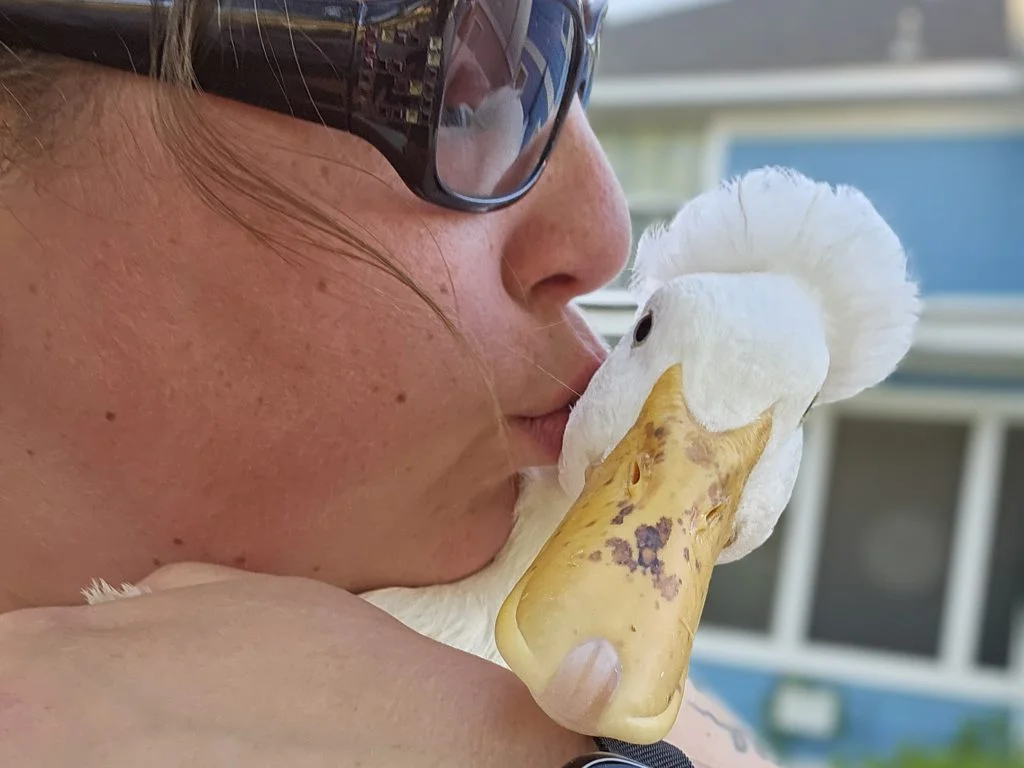
Are Male or Female Ducks Better Pets?
The question of whether male or female ducks make better pets ultimately depends on your preferences and lifestyle. Drakes can be charming with their colorful plumage and spirited personalities, while ducks are known for their nurturing instincts and gentle demeanor. With proper care and attention, both genders can make delightful additions to your flock, bringing joy and companionship for years to come.
Conclusion
As we wrap up our quacky exploration of male vs female ducks, it’s clear that each gender brings its own unique charm and characteristics to the table. Whether you’re marveling at a drake’s vibrant colors or admiring a duck’s nurturing nature, there’s no denying the magic of these feathered friends. So, here’s to celebrating the wonderful world of ducks and their joy in our lives!

